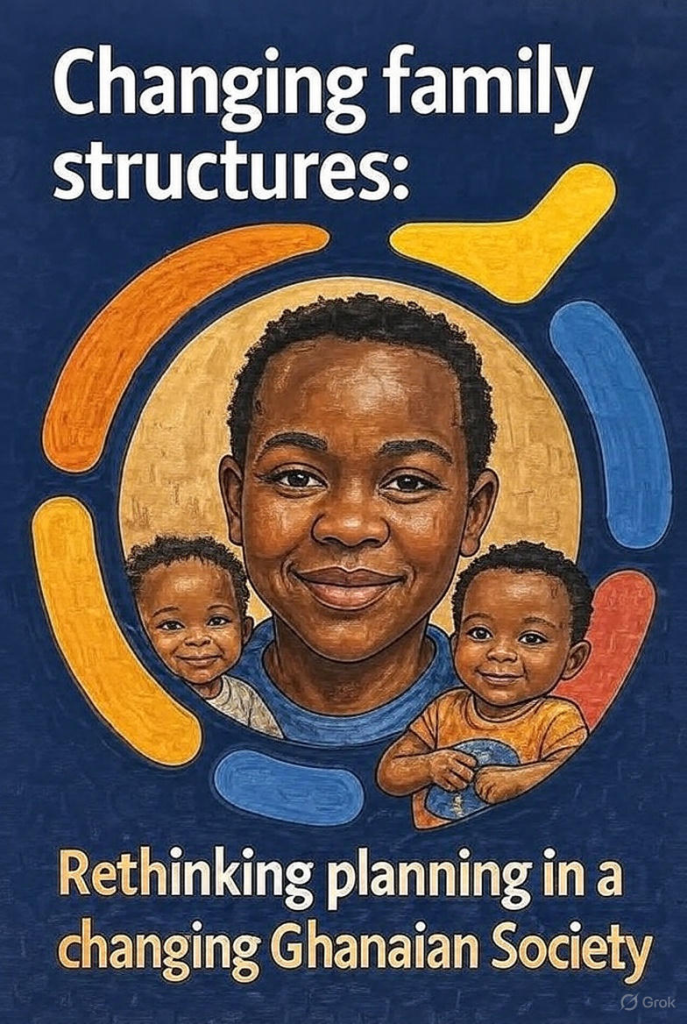Changing family structures: Rethinking planning in a changing Ghanaian Society

Ghana is urbanising and undergoing social and spatial transformation. Beneath the concrete buildings, traffic congestion, noise of political debates, and development targets lies a quieter, more intimate revolution, the changing Ghanaian family. The transformation of the extended family to a nuclear family structure is evident in Ghanaian societies today. This transition is not just about how people marry or raise children; it is a structural transformation that cuts to the heart of urban life, social welfare, and economic planning.
Families have always been central social institutions worldwide, shaping individual lives and the broader society. In Ghana, like much of Africa, the extended family system, where multiple generations and relatives live closely and support one another, has historically been the foundation of social and economic well-being. This system reflects deeply held cultural values, customs, and kinship bonds.
However, as with global trends, Ghanaian families are experiencing significant changes. Modern influences such as education, urbanisation, industrialisation, and globalisation are reshaping family structures, roles, and relationships. This transition of family systems throughout the world is seen by demographers as the ‘second demographic transition’1. While the extended family remains valued in many communities, nuclear family patterns with smaller household sizes are increasingly common, particularly in urban areas.
Ghanaian families are shifting from large (6–8 children) to smaller household sizes (3–4 children), reflecting broader trends in sub-Saharan Africa influenced by family planning and socioeconomic development. For instance, the average household sizes decreased from 4.1 in 2010 to 3.3 in 2021 in urban areas, suggesting changes in family structures and living arrangements2. The Ghanaian family has always been the invisible architecture that sustained care, housing, inheritance, and survival. As that structure fragments, so too does the social foundation upon which our cities are built.
Mark Granovetter’s embeddedness theory offers a powerful lens for understanding this phenomenon. He posits that social life is embedded in networks of relationships, trust, and obligations. He argues that economic action is “embedded” in ongoing social relationships, networks, and norms and cannot be understood apart from them. The theory positions social relations as constitutive of economic behaviour thus people’s economic actions are shaped, enabled, and constrained by their social networks. Trust, reputation, and reciprocity emerge through these networks, reducing uncertainty and fostering cooperation in markets (Granovetter 1985). The Ghanaian extended family was precisely such a network, a living system that embedded care, welfare, and production within kinship.
Planning, in the traditional sense, was not formalised by blueprints or zoning ordinances. It was enacted through shared compounds, communal courtyards, and the intergenerational use of space. Land was not merely a parcel; it was a relationship. A grandmother’s room faced the courtyard so she could watch the children play. A cousin’s kiosk was not “mixed-use development”; it was a livelihood by proximity. As urbanisation redraws the contours of extended family life, this embeddedness is eroding. We are witnessing the rise of “disembedded” households where individuals are living alone in rented rooms, dual-income couples outsourcing childcare, and elderly parents left in rural homes while adult children chase urban survival 3. These changes have spatial connotations.
The truth is that the social contract of care is collapsing, and the built environment must now take on the roles once fulfilled by family. In the past, the extended family cared for the elderly; today, many old people live alone, unsupported, in both rural and urban settings. This means that planning for the future must include social infrastructure such as old-age homes, day-care centres, community kitchens, and funeral homes, facilities once managed informally by the family network.
Similarly, the rise in female-headed households and dual-working parents has created new demands for accessible childcare, flexible housing designs, and neighbourhood-based day-care centres. Without them, urban productivity suffers, particularly for women. The economic implications are significant: when care becomes commodified, household budgets strain, and inequality deepens. The modern Ghanaian family is mobile, fragmented, and under economic pressure, and planning must evolve to reflect this.
The traditional family once absorbed shocks that today require state or market intervention such as childcare, elder care, housing for dependents, and even funeral expenses. As kinship networks weaken, the costs of welfare are shifting from the family to the individual, and by extension, to the state and market. This creates a dual challenge for Ghana’s development planning. For instance, there is a rising demand for social infrastructure, from affordable rental housing and nursing homes to mental health services and community recreation spaces. Also, the monetisation of care risks excluding the poor and widening inequality.
This changing demography serves as a cue for planners to anticipate these pressures; for instance, the elderly population is growing, yet Ghana lacks structured geriatric housing or senior day-care facilities. Rural – Urban migration leaves behind “empty villages” of ageing parents, calling for integrated rural service centres. Funeral homes and crematoriums, once taboo, are becoming a planning necessity in dense urban zones (eg Accra). Childcare centres are moving from informal compounds into formal community facilities, built into zoning codes.
The National Development Planning Commission (NDPC), Metropolitan, Municipal and District Assemblies (MMDAs), and private developers must rethink planning through a social lens. The Ghanaian city of the future must be a social organism, not just a spatial one. It should fill the responsibilities families once did, thus nurture, protect, and sustain.
By Macdonald Abopaam
Metropolitan Governance and Local Economic Development Unit
References
Kay, J. (2020). The African family in crisis: A brief analysis of the transitions and changing trends in the modern African family. SSRN. https://doi.org/10.2139/ssrn.3687354
Dzramedo, J. E., Amoako, B. M., & Amos, P. M. (2018). The state of the extended family system in Ghana: Perceptions of some families. Volta Journal of Education, 8(24), 45–51.
Ghana Statistical Service (2021). 2021 Population and Housing Census General Report, Volume 3A; Population of Regions and District
Granovetter, M. (1985). Economic action and social structure: The problem of embeddedness. American Journal of Sociology, 91(3), 481–510. https://doi.org/10.1086/228311
